New Update: Boost Social Proof with Reviews & Automation
New Update: Boost Social Proof with Reviews & Automation
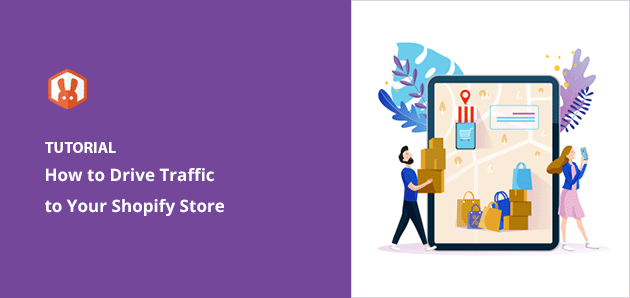
 John Turner
John Turner
 John Turner
John Turner
Want to know how to drive traffic to your Shopify store and get more sales?
As someone who’s run Shopify sites myself, I’ve learned that getting traffic is one of the hardest parts. It’s not just about having a great product, you need the right mix of tools, content, and strategies to bring people in.
In this guide, I’ll show you proven ways to drive traffic to a Shopify store. These tips work whether you’re brand new or looking to grow faster.
You’ll learn how to use giveaways, social media, SEO, email, and more to get the right visitors to your site, and turn them into buyers.
Quick summary: To get more traffic to your Shopify store, focus on building your email list, boosting social shares, improving SEO, and offering incentives like giveaways and discounts. These 12 traffic tips are beginner-friendly and don’t require coding.
Traffic is vital for your eCommerce business because it reflects the number of people visiting your website and potential customers. The more traffic you have, the bigger the chance of making sales and increasing revenue.
Additionally, traffic can help you boost brand awareness and credibility. This is because more people will become familiar with your business.
Furthermore, organic traffic is key to search engine optimization (SEO).
Search engines like Google and Bing use traffic to understand the relevance and popularity of a website. If yours has high traffic, search engines will likely recognize it as valuable and trustworthy.
This can improve your search engine rankings and make it easier for shoppers to find you.
Overall, driving traffic to your Shopify store is crucial for increasing sales, building brand recognition, and improving your online visibility. By attracting more visitors, you can increase your chances of success and growth.
So, how exactly do you drive traffic to a Shopify store? Below I’ll show you how with the help of clever content marketing, social media advertising, and more.
In no time, you’ll have everything you need to drive your audience’s attention to your online store.
Let’s dive in!
Giveaways are one of the fastest ways to attract customers to your Shopify store. They create excitement and give people a reason to check out your products. People love getting something for free, and a giveaway incentivizes them to engage with your brand and visit your store, resulting in more traffic and exposure.
When you run a giveaway, you can require people to follow your social media accounts, subscribe to your email list, or share your content with friends. This can help increase brand awareness and reach a wider audience.
Similarly, a contest can encourage people to create user-generated content (UGC), like photos or videos, showcasing your products. Doing so can provide social proof and help build a community around your small business.
If your Shopify store is integrated with WordPress, I recommend using a giveaway plugin for your contest.
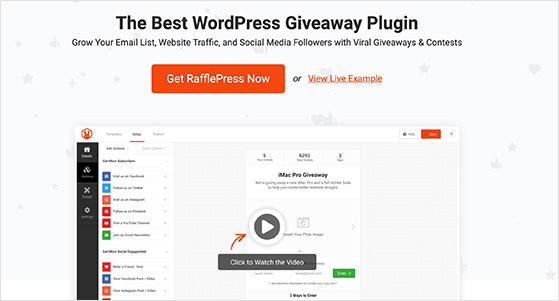
RafflePress is the most powerful and easy-to-use giveaway builder for WordPress. It has a drag-and-drop interface and countless ways to boost your store’s traffic.
For example, the ‘Refer-a-Friend‘ action helps attract referral traffic. And with the ‘Visit a Page’ action, you can send high-quality website traffic to product pages in your store.
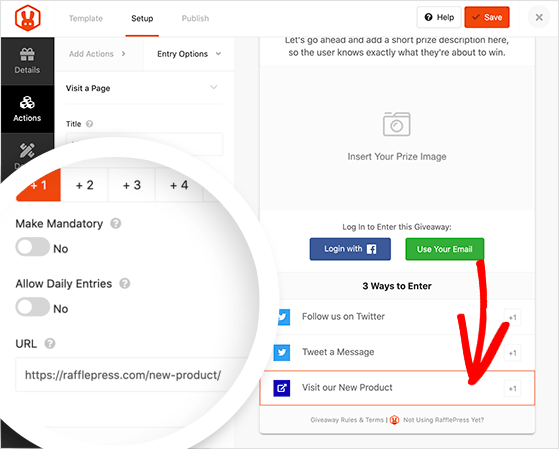
You also won’t need to start from scratch. RafflePress has several pre-made giveaway templates to help you:
Best of all, you can do it all with zero coding. Follow this guide to learn how to run a Shopify giveaway in WordPress.
If you need proof, you can see how Smash Balloon got over 3k+ email subscribers with a RafflePress giveaway.
Sending push notifications is a great way to drive traffic to your Shopify store. They can remind customers that your store exists, promote sales and showcase new products.

By sending push notifications, you can keep your brand top of mind and encourage potential customers to visit your store and make a purchase. However, it’s important to use them strategically and avoid overwhelming users with too many, as this could lead to less engagement.
To send push notifications, we recommend using push notification software like PushEngage.
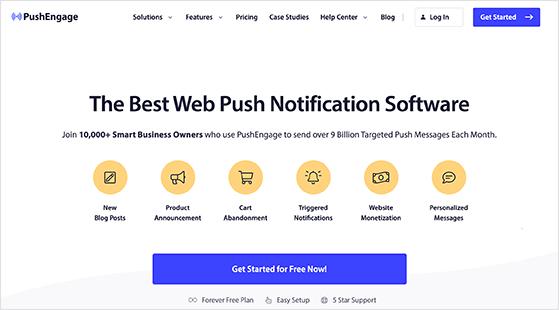
PushEngage is the easiest way to send custom push notifications to your website visitors. It offers various features to create effective push notification campaigns, including:
Furthermore, the platform integrates with Shopify, WooCommerce, and Magento, making it easy for Shopify store owners to set up and manage campaigns.
If you’re ready to dive in, you can follow this guide on how to add push notifications to your website.
Shopify SEO can be challenging for beginners. However, optimizing your store with the right keywords can drive free traffic to your website through search engines like Google Search and Bing.
By finding and using relevant keywords, you can increase your store’s visibility in search engine results pages (SERPs). We call this organic search because it’s how shoppers naturally look for answers to their problems.
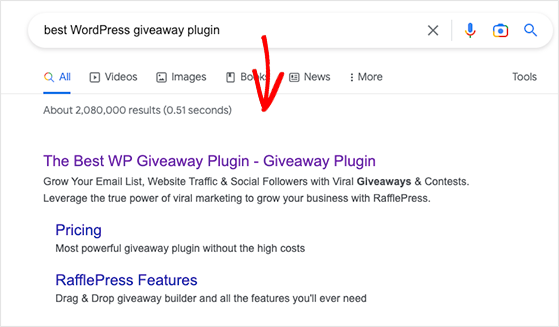
To optimize your site with keywords specific to your store, you should perform keyword research. Doing so will help you find the most relevant and high-traffic terms for your products and industry.
SEMRush’s keyword magic feature is a great tool for this because it gathers search data in one place.
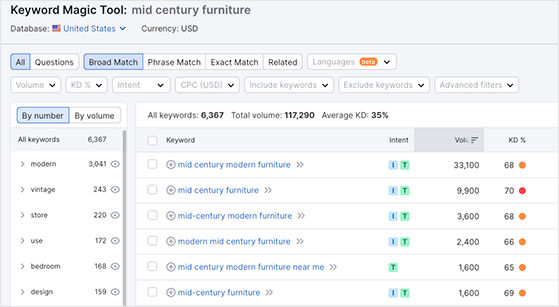
It can also help you track your rankings, research competitors, and more.
Then, you can use those keywords throughout your website, such as your:
Using the right keywords can help improve your site’s search engine rankings, making it more likely that people will find your store when they search for related products. This can increase the traffic to your store and generate more sales for your business.
Similarly, writing SEO-friendly blog content for your store is a great way to drive traffic and increase conversions. By creating valuable content, such as tutorials, gift guides, news, and updates, you can engage existing customers and attract new customers through organic search.
Like tip 3, you’ll need to start by finding the best keywords for your content. From there, you can use those keywords in your post, such as in your headline, subheadings, and post body.
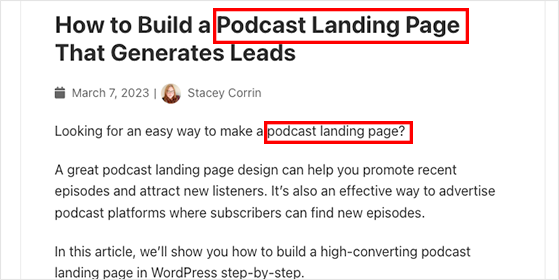
However, using keywords naturally and not overstuffing them is crucial, as this can negatively affect your search engine rankings.
Email marketing is often overlooked as a powerful method for sending traffic to online stores. However, leveraging your email list allows you to communicate with your audience directly and encourage them to visit your website.
To create an email marketing campaign, you’ll first need to build an email list. You can do that by offering incentives such as exclusive discounts, giveaways (see tip 1), free guides, eBooks, or other valuable content.
Once you have an email list, you can send regular emails to your subscribers to promote your products, offer discounts, and provide updates related to your industry.
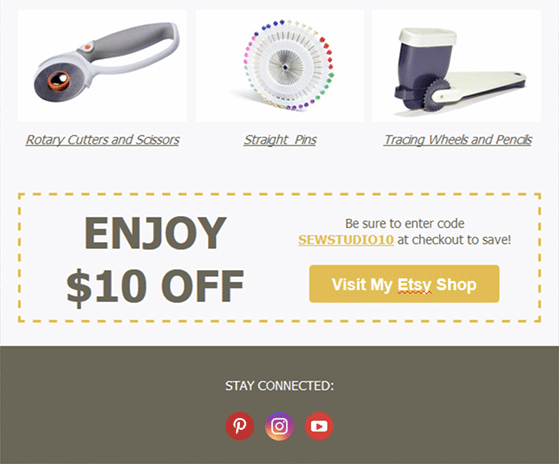
With email marketing, you can reach users who are already interested in your brand and products, which can encourage them to visit your website and make a purchase.
Additionally, you can segment your audience and personalize your messaging. This can make your emails more relevant and engaging, helping to boost your conversion rates.
Social media platforms can also drive traffic to your Shopify store. When you share valuable content and engage with your followers on social media, you can attract new visitors to your website.
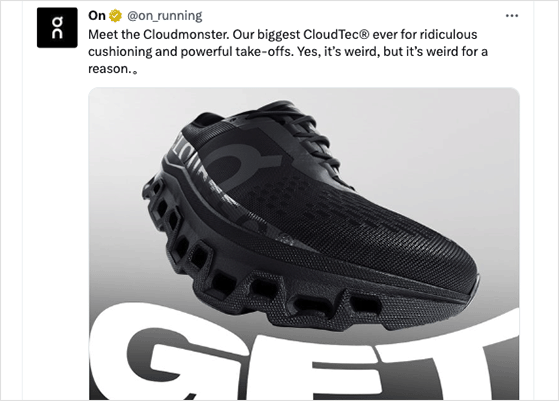
Start by finding the social media networks relevant to your business and audience.
Platforms like Facebook, Instagram, and Twitter are effective for reaching a broad audience. Still, niche platforms like Pinterest, Reddit, and Goodreads may be more relevant depending on the products you sell.
After finding the best social media platforms, you can create and share engaging content that resonates with your audience.
Here are a few ideas of the type of social media posts you can share:
You can even display social media posts on your website with social media feed plugins like Smash Balloon.
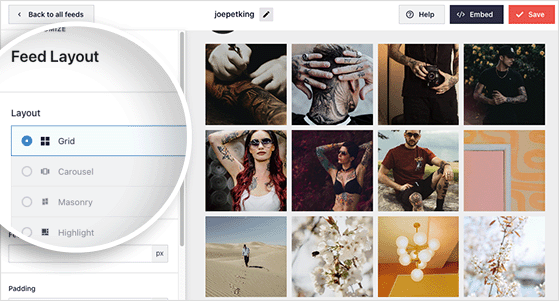
That way, you can engage your visitors with content from your community, proving that your brand is credible and trustworthy.
Affiliate marketing is another excellent way to increase traffic without spending a fortune on paid advertising. By offering commissions to affiliates who promote your products, you can encourage them to share your goods with their audience, driving traffic to your website.
However, starting an affiliate program from scratch can be complex and expensive. It takes a lot of work to set everything up manually.
That’s why I recommend using an affiliate marketing plugin like AffiliateWP to create your referral program.
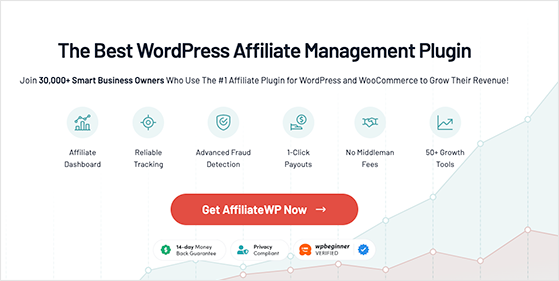
AffiliateWP makes creating an affiliate program for your online store easy. It’s a popular and reliable plugin that requires zero coding to set up.
This plugin allows you to grow your network with automated tools, helping you save time and effort.
Here’s a quick overview of what you can do with AffiliateWP:
Check out our easy tutorial to learn how to set up an affiliate program with AffiliateWP.
With a well-crafted poll or survey, you can collect useful information from your store’s visitors and use it to make informed decisions to improve your business.
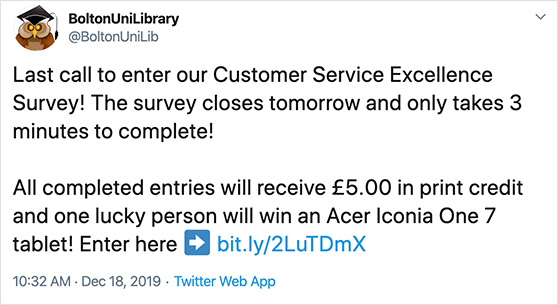
For example, feedback from a survey might show that browsing your store is difficult, prompting you to make it more user-friendly.
Plus, surveys can also help you generate leads, especially if you include an email opt-in checkbox and an incentive for users, such as entry into a giveaway or a discount code.
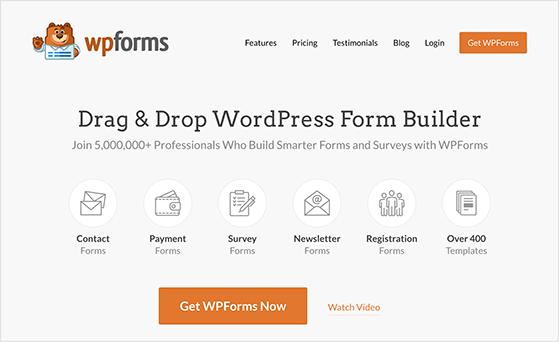
My favorite tool for this is WPForms, the most beginner-friendly form builder for WordPress. With its drag-and-drop builder, hundreds of form templates, and extensive features, it’s the easiest way to add surveys to your online store.
With this powerful plugin, you can easily create:
For even more details, you can read this guide on adding a survey to WordPress with WPForms.
In the last tip, we mentioned using incentives to get people to take action, and nothing is a greater incentive than money off a purchase. With discounts and coupons, you can attract new visitors to your website, engage existing customers, and encourage them to buy something they have their eye on.
You can use the discounts feature in the Shopify app to create a discount or offer free shipping. Afterward, you can promote your offers through your site, email, social media, and other channels to encourage shoppers to purchase.
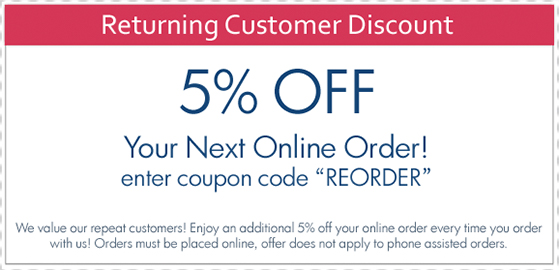
One tool we love for promoting discounts is OptinMonster. With its different campaign types, you can draw attention to your offer by:
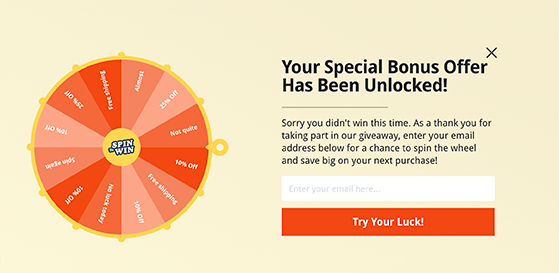
Even better, OptinMonster has advanced targeting features, allowing you to show your discount to the right visitors at just the right time. For example, you can display an exit-intent popup with your discount when users are about to leave your site or offer an exclusive discount to first-time visitors.
Here’s a quick guide showing you how to add an exit popup to Shopify with OptinMonster:
Influencer marketing is a tried and tested way to drive traffic to online stores. By partnering with them, you can leverage the influencer’s existing audience to reach new audiences and send traffic to your website.
Start by researching influencers in your niche who fit your brand. After finding the right people, you can build relationships with them by engaging with their content, joining social media conversations, and generally offering value.
After building your relationship, you can propose a partnership or collaboration, such as:
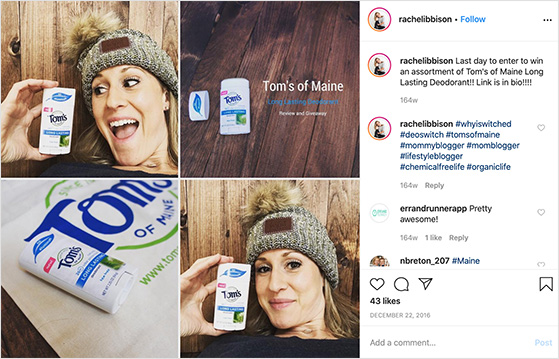
Collaborations like this can also create valuable backlinks to your site, which can help demonstrate its authority to the Google algorithm.
Since influencers have an engaged audience ready to trust their opinions, working with them can attract new visitors to your Shopify store who may not have otherwise discovered your products.
Podcasting can drive traffic to your Shopify store by giving you a platform to showcase your brand and expertise. With engaging podcast content, you can establish yourself as an authority, build trust, and drive traffic to your store with promotions and calls to action.
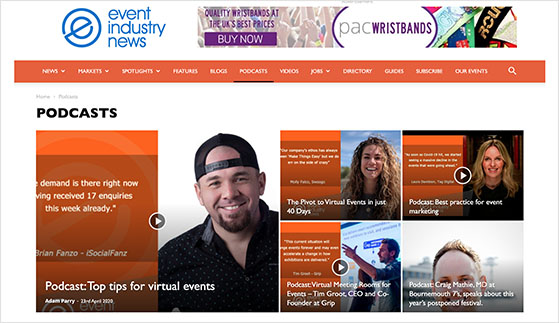
Alternatively, sponsoring a podcast that aligns with your values can help you reach a wider audience and tap into the existing trust and loyalty of the podcast’s listeners. As a result, you can send more traffic to your store through referral links, coupon codes, and other promotional offers.
If you plan to run or sponsor a podcast, you’ll find these tips on promoting a podcast helpful.
My final tip on sending traffic to your Shopify site is to leverage the power of paid advertising. While it isn’t the most budget-friendly tip, paid ads are fantastic for reaching new audiences who may not know of your brand.
With platforms like Google Ads and Facebook Ads, you can create highly targeted campaigns that reach people based on their demographics, behaviors, and interests. You can even retarget people who have already visited your site but have yet to make a purchase.
In particular, business accounts on Facebook and Instagram ads let you create engaging carousel, slideshow, video, and poll ads to help you stand out from your competitors.
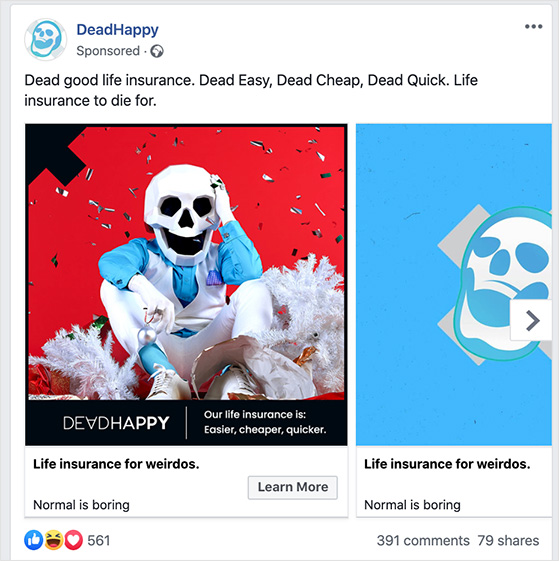
This can help you increase brand awareness, generate leads, and drive sales while tracking your results with metrics like click-through and conversion rates.
Additionally, paid ads can help you stay competitive in a crowded online marketplace by giving you more visibility and exposure. Since you can test and refine your messaging and targeting over time, you can optimize your ads for the best results.
Some other places that allow you to run social media ads and PPC campaigns are as follows:
Remember that the key to success with paid ads is to understand your target audience and their needs clearly, and to create compelling ad content and landing pages that resonate and drive them to take action.
In this article, I’ve shown you how to drive traffic to Shopify store websites using a combination of digital, content, and social media marketing, lead generation and paid advertising methods.
Next, check out this step-by-step guide on how to use contest marketing to grow your business.
If you liked this article, please subscribe to our YouTube Channel for RafflePress video tutorials. You can also find us on Twitter and Facebook.
Disclosure: Our content is reader-supported. This means if you click on some of our links, then we may earn a commission. We only recommend products that we believe will add value to our readers.
Copyright © 2024 SeedProd LLC. RafflePress® is a registered trademark of SeedProd LLC